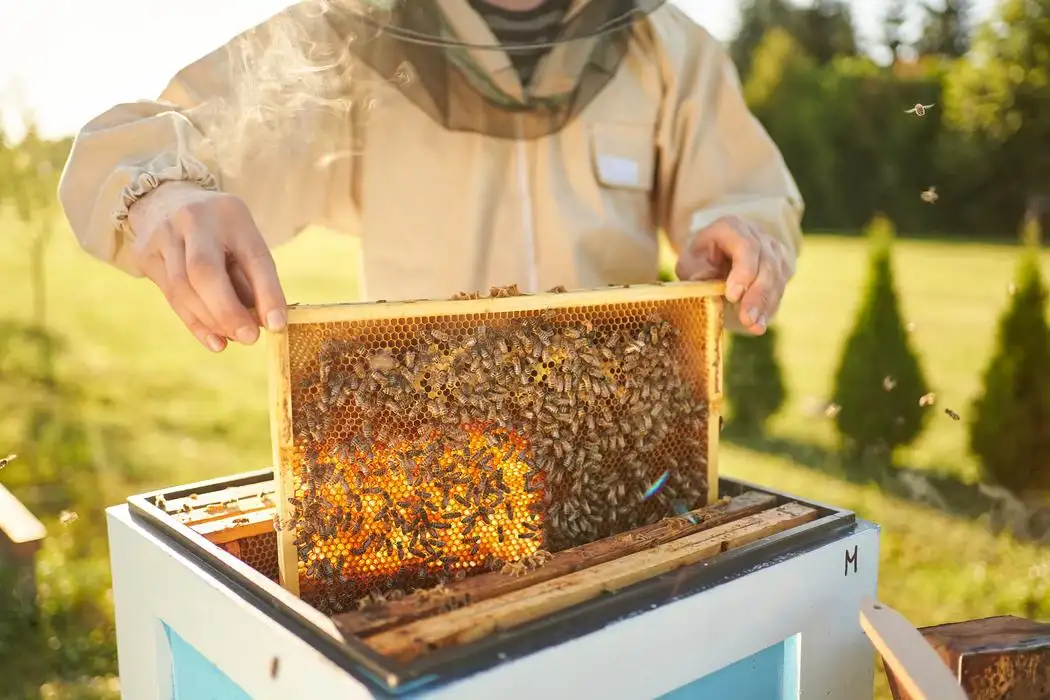Introduction
Apiculture is the practice of culturing honey bees on a bigger scale to yield beeswax and honey. It is a scientific approach to rear the bees in man-made hives, raising their numbers and caring for them. Beekeepers or apiarists are those who practice apiculture. Man-made beehives are artificial bee hives. These are made of wooden boxes and contain rows. Bees stay in these hives and fill the rows with wax, honey, etc. The designs of these hives should be such that they will facilitate the healthy growth of bees and honey harvesting.
How honey is collected by honey bees?
Long distances are covered by worker bees as they search for food. Their honey stomachs serve as temporary storage for the nectar they obtain from flowers. When they get to the hive, they regurgitate this nectar and deposit it in honeycombs. The regurgitation is a viscous liquid called honey that has undergone dehydration.
The life cycle of the Honey bee
Honey bees go through four developmental stages. They begin as eggs, grow into larvae, then transition into the pupa stage before reaching adulthood.
- Egg stage- After a drone successfully fertilizes a queen bee, she lays both fertilized and unfertilized eggs. A queen bee may produce between 2000 and 3000 eggs every day, each of which is contained in a cell. Unfertilized eggs grow into male drones, whereas fertilized eggs become worker bees.
- Larval stage-After three days the eggs hatch into worm-like larvae. Larvae are without legs, wings, or other appendages. Royal jelly is provided to larvae during the first two to three days, followed by pollen and honey. Only royal jelly is used to feed the queen larva.
- Pupal stage-In this stage the larvae wrap themselves up in a cocoon and enclose themselves in their cells. During the pupal stage, all organs such as the abdomen, head, eyes, thorax, and appendages including wings, legs, and antennae are developed completely.
- Adult stage- Once the larvae develop, they appear like adult bees after they hatch out from the capped cell.
Common varieties of bees
Common honey bee species include-
- Apis dorsata.– As well known as rock bees they are enormous, vicious bees. The raising of rock bees is challenging.
- Apis Florea– Referred to as “little bees” because of their tiny size. They rarely sting, but because they move around a lot, domestication is fairly challenging.
- Apis mellifera– Also known as the western bee or European bee. It is the most domesticated species in the world and stings less frequently.
- Apis indica– Frequently called Asian bees or Indian bees. They originated in Asia and are simple to domesticate to make honey.
Importance of Beekeeping
- The purpose of apiculture is to produce bee products that have a marketable value.
- Honey is the main apicultural product that is obtained. Because of its distinct sweetness, honey is employed extensively in the food sector.
- Additionally, several therapeutic herbs and honey are combined in some traditional medicines.
- The glandular fluid made by honey bees for the construction of the honeycombs in which they store their honey is known as beeswax.
- In the production of soaps, candles, and cosmetics, beeswax is commonly used.
- Another type of glandular fluid produced by worker honey bees, which is used for feeding queen bee larvae is the royal jelly.
- This royal jelly improves collagen synthesis and helps women who are experiencing menopause-related issues.
- Propolis, a resin-like substance made by honey bees, has antiviral and antibacterial properties.
- Bee venom has been shown in several trials to be effective in combating the Human Immunodeficiency Virus (HIV).
- Beekeeping also has environmental benefits as bees are great pollinators and help in fruit formation.
Summary
Apiculture is the scientific process of rearing honey bees in artificial hives to produce bee products such as honey, wax, royal jelly, and propolis for the market. An apiculturist is a person who does apiculture. In addition to providing advantages to business and industry, apiculture supports numerous plant species through pollination.
- The species of bee most frequently raised for the production of honey is Apis mellifera.
- Apiculturists take care of wooden-framed hives where honey bees can breed and grow.
Most apiaries are designed around bee pastures because they make excellent locations for bee foraging. Queen bee, worker bees, and drones are present in every bee colony. Within their colony, they are assigned specific duties. The life cycle of honey bees has four stages. Queen bee lays eggs that completely metamorphose into adult bees.
Frequently Asked Questions
1. How do bees act as pollinators?
The pollen grains from stamens land on the hairy region of the hind legs of the bees while they are collecting nectar. When the honey bees visit another flower they deposit pollen grains there and hence aid in cross-pollination. Honey bees are therefore referred to be pollinators because of this.
2. What are the various types of bees found in a bee hive?
Ans: There are a lot of bees within the bee hive. They can be divided into three primary groups.
- Queen Bee- The only female in the bee hive with the ability to lay eggs is the queen bee. The queen uses pheromone emissions to regulate the entire hive population.
- Drones or male bees- They are the male population of the hive that fights it to mate with the queen bee. After mating, the drone bee dies.
- Worker bees- These bees are female and unable to lay eggs. They are the bee hive’s active population. Worker bees perform a variety of tasks, such as maintaining and cleaning the hive, and feeding larvae and queen bees. They produce honey and gather the nutrients required for the hive population.
3. Who is known as the father of apiculture?
Ans: The father of modern apiology and apiculture is Johann Dzierzon. Most modern beehives derive from his design.


